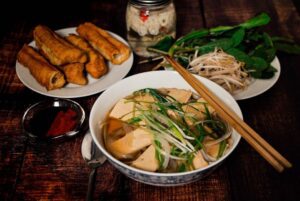Culture Tuesday is a monthly column in which Best of Vegan Editor Samantha Onyemenam explores the cuisines of different cultures across the globe through a plant-based and vegan lens. This article delves into the history and characteristics of Guyanese Cuisine.



Guyana’s Cultural Fusion: Exploring Guyanese Cuisine
A Culinary Blend: Cultural Influences in Guyanese Cuisine
Guyana is a country located in South America with a culture that is connected to that of the Caribbean region. This cultural connection is displayed in the cuisine of the country which also features a blend of African, Indian, European, and Indigenous influences.
Indigenous Roots: Pre-European Culinary Traditions in Guyana
Guyana’s cuisine is a reflection of the country’s complex history and cultural influences. The indigenous people who inhabited Guyana before European colonisation had their own culinary traditions, which included cassava, and other locally grown foods.
European Influence: New Ingredients and Cooking Methods
When the Europeans arrived, they brought new ingredients and cooking methods, such as sugar, molasses, and spices.
African Influence: Enslaved Africans and Their Culinary Traditions
They also brought enslaved Africans to work on plantations, who brought their own culinary traditions and influences to the region.


Indian Influence: Arrival of Indian Indentured Labourers and Their Cuisine
In the 19th century, Indian indentured labourers arrived in Guyana to work on sugar plantations. They brought with them their own cuisine, including curries, roti, and dhal, which have become an integral part of Guyanese cuisine.
Creole Cuisine: Blending African, European, and Indian Flavors
Over time, the various cultural influences blended together, resulting in a unique fusion cuisine that is often referred to as “Creole.” This cuisine combines African, European, and Indian flavours and techniques, as well as ingredients that are native to the region.
In more recent years, Guyanese cuisine has continued to evolve and incorporate influences from other parts of the Caribbean and the world. Today, Guyanese cuisine remains a reflection of the country’s rich history and diverse cultural influences, and it continues to be a source of pride for the people of Guyana.
Must-Try Guyanese Dishes: A Taste of Guyana
Cook-up Rice: A One-Pot Rice and Peas Dish (Vegan-friendly version included)
Cook-up Rice is one of the most popular dishes in Guyana. It was introduced to Guyana by enslaved Africans who developed methods to make delicious meals out of unwanted foods and available ingredients when rations are low. Cook-up rice is a one-pot rice and peas dish that’s simmered in coconut milk. Although it is often made with meat, some Guyanese homecooks make it more accessible to an audience with varying dietary requirements by making a vegan-friendly version which can be served with sides.
Cook-up rice is made through a combination of aromatic vegetables (onions and garlic), chilli peppers (such as scotch bonnet or wiri wiri), casareep (a thick black liquid made from cassava root), rice, tomatoes, herbs, spices, and peas of choice (often pigeon peas or black eyed peas). Other ingredients such as leafy vegetables or green plantains are added by some cooks for variation at times.
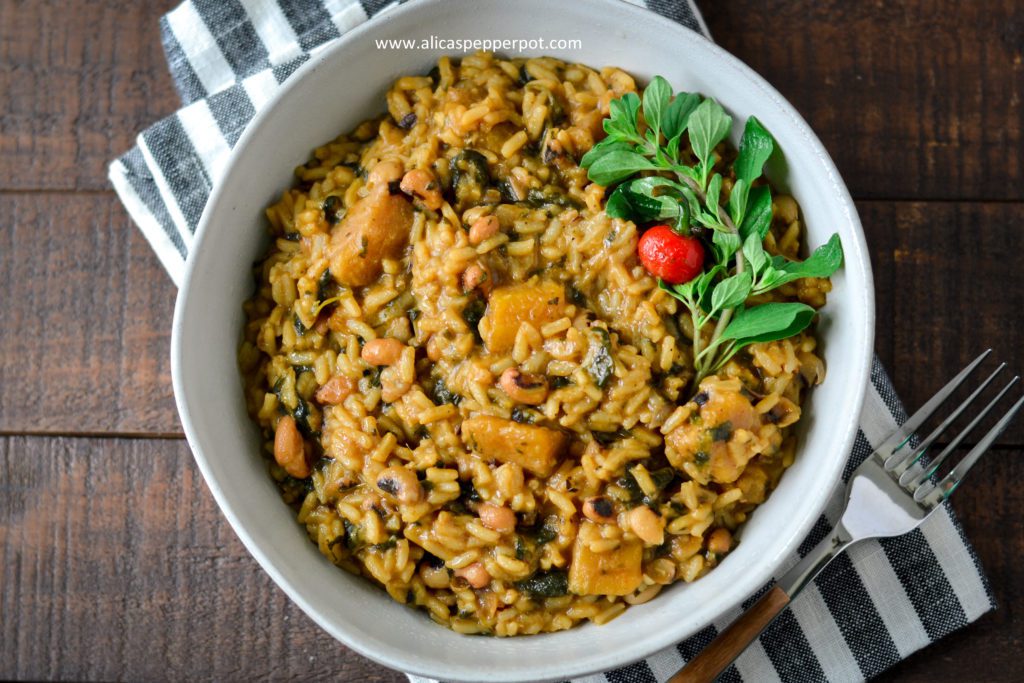

Pepperpot: A Rich and Flavorful Stew (Traditional and Vegan Variations)
Pepperpot is the National dish of Guyana. It is a dish with First Nation origins (it originated amongst the indigenous inhabitants of northern region of South America) – specifically, it originated amongst the Arawak people of the Lokono nation. Pepperpot is a rich and flavourful stew that typically includes a variety of meat, cassareep, brown sugar, fresh thyme, cloves, cinnamon, spices, garlic, and wiri wiri (or scotch bonnet) chilli peppers. However, plantbased cooks make it with unripe/young jackfruit, mushrooms, or vegan beef substitutes in place of meat and other cooks also include vegetables, such as cassava, green plantain, and sweet potato in it at times. These ingredients are combined and simmered slowly to create a hearty stew.
One of the defining characteristics of pepperpot is the use of cassareep. As aforementioned, this is a thick dark sauce made from cassava juice. Cassareep gives the stew its dark colour and distinctive flavour. It is made by boiling grated cassava root and then allowing the liquid to reduce and concentrate, resulting in a syrup-like consistency.
Pepperpot is often served with rice, roti, or bread, and it is a popular dish for special occasions and holidays, especially Christmas. The long cooking process allows the flavors to develop and meld together, resulting in a dish that is savoury, aromatic, and deeply satisfying.
Overall, pepperpot is a comforting stew that showcases the flavours of Guyanese cuisine. It has become a beloved dish both in the Guyana and among people around the world who appreciate its unique and vibrant flavours.
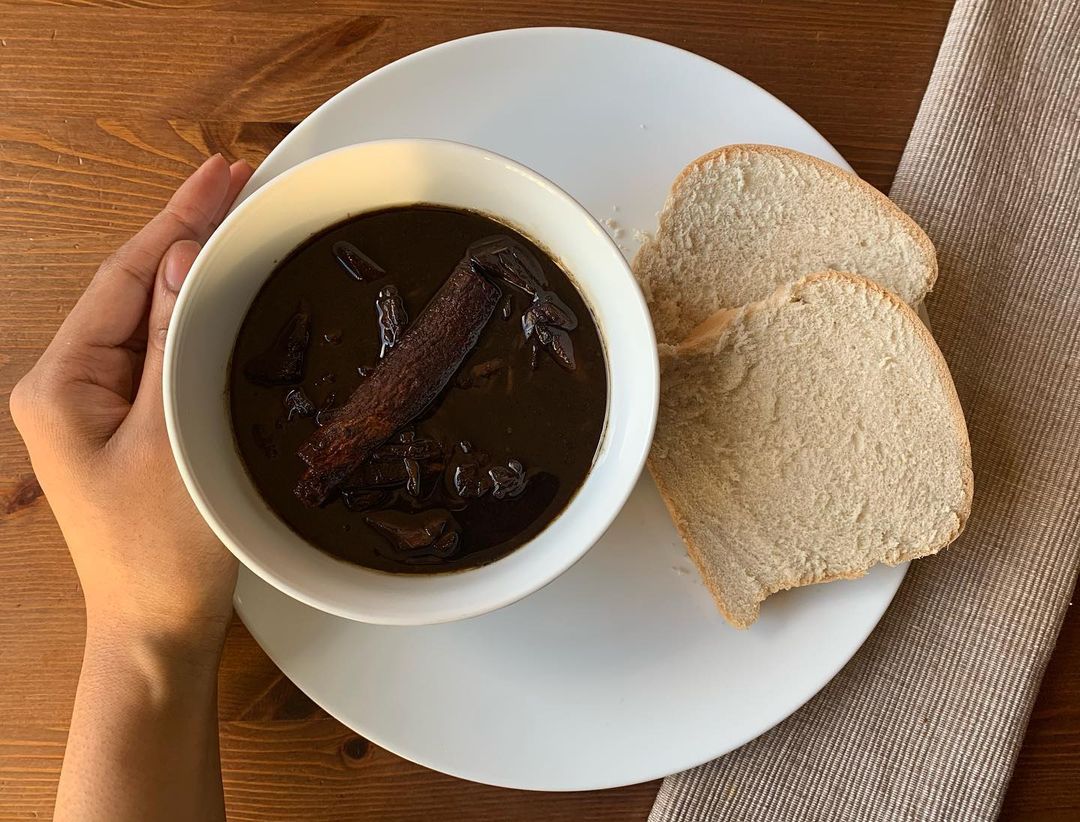

Fry Ochro: Crispy and Savory Fried Okra
Fry Ochro, also known as fried okra, is a popular dish in Guyanese cuisine. Okra, also referred to as ochro, lady’s finger, or bhindi, is a green, elongated vegetable with a unique texture and flavour. When cooked, it becomes tender on the inside while maintaining a slightly crispy exterior.
To prepare fry ochroes, fresh okra pods are washed and dried before being sliced into thin rounds. The okra is roasted/dried in the oven to reduce, or completely eliminate, sliminess, then seasoned with salt.
In a frying pan or skillet, oil is heated, and sliced onions, garlic and chilli peppers are sautéed before the seasoned okra is added. The okra is then cooked over medium to high heat, allowing it to fry until it turns golden brown or reaches a desired level of doneness. The high heat helps to minimize the sliminess often associated with okra.
Once the fry ochro is cooked to perfection, it is commonly served as a side dish alongside main courses in Guyanese cuisine. It pairs well with rice and dhal, curry dishes, and roti. The crispy texture and savoury flavour of fry ochro make it a beloved dish among Guyanese people and those who appreciate the flavours of the Caribbean region.
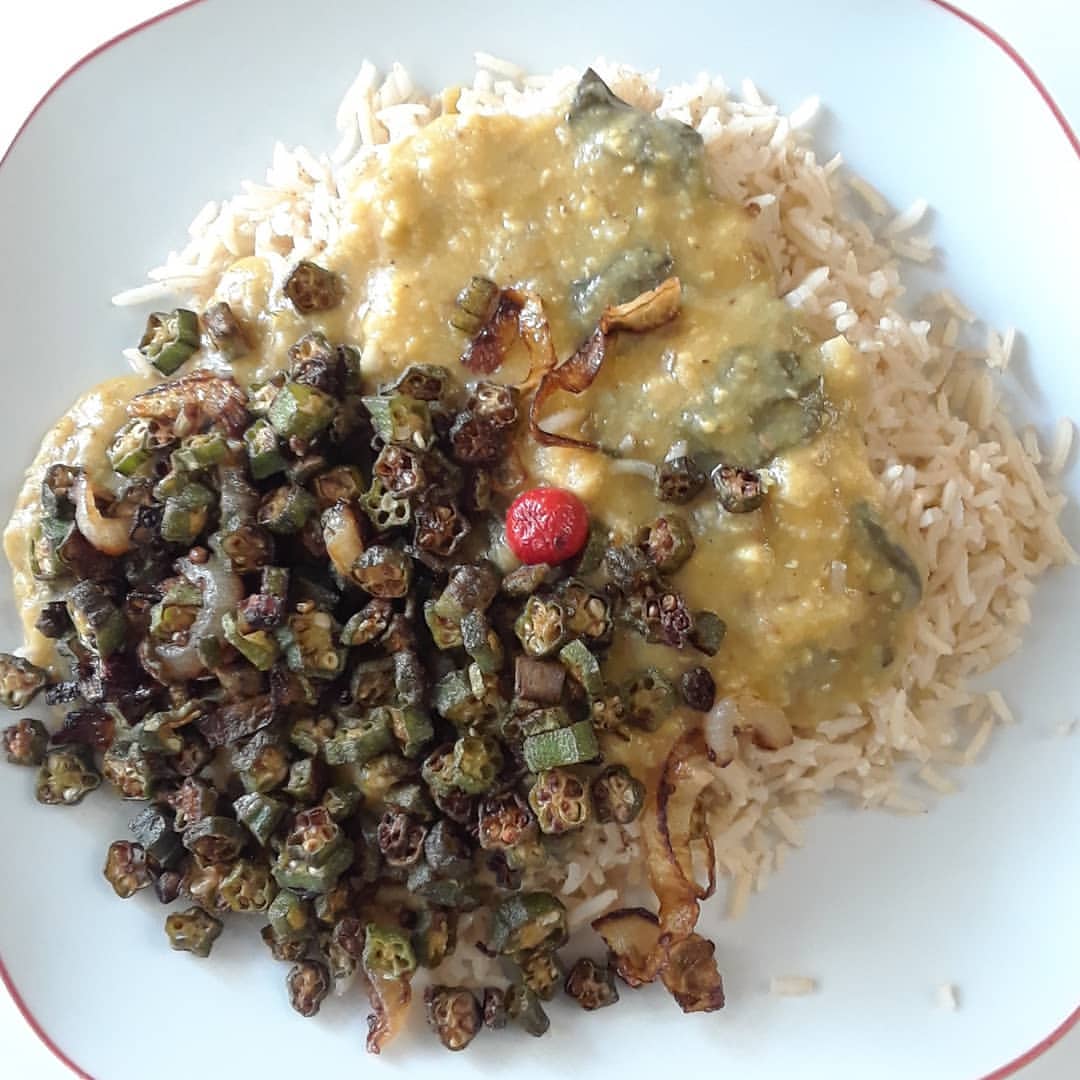

RECIPE: Fried Okra
Guyanese Fried Rice: Aromatic and Delicious Rice Dish (Vegan-friendly version included)
Guyanese fried rice is a flavourful and aromatic dish that is made with a medley of rice, vegetables, and spices. It is also often made with meat. However, it is easily veganised through the omission of meat and/or using plantbased meat alternatives as substitutes for the meat.
This dish originated during the Sui Dynasty in China and was brought to Guyana by Chinese labourers. Although the original recipe was Chinese and is still made as a Chinese dish in the Chinese restaurants located in Guyana, the Guyanese people have developed their own version of this dish using local vegetables and spices.
The rice (usually long grain, jasmine, or basmati) is often cooked a day, or several hours in advance and left to cook completely to prevent it from becoming sticky when combined with the vegetables during the frying process. Common ingredients used when making Guyanese fried rice include carrots, cabbage, corn, onions, garlic, bell peppers, chilli peppers, bora beans, soy sauce, oil, herbs, and spices.
The aromatic vegetables are usually cooked till fragrant before the harder vegetables such as the carrots and beans are added in. The softer vegetables are sautéed last to avoid overcooking them. The rice is tossed in till fully combined with the vegetables. The sauces and spices are also tossed in till evenly distributed and their flavours have been absorbed by the rice and vegetables. The resulting dish is a fragrant and satisfying rice dish that’s perfect for any day and any event.


Cassava Balls: Popular Snack and Street Food in Guyana
Cassava balls are a popular snack and street food in Guyana. Cassava balls are made by mashing cassava that has been peeled and cooked in boiling water until smooth. The resulting cassava mash in combined with other ingredients to form a dough-like mixture. The mashed cassava is usually mixed with seasonings such as salt, garlic, onion, chilli pepper, and various herbs and spices, which can vary depending on personal preferences and regional variations.
Once the cassava mixture is well combined, it is shaped into small balls or rounded patties, about the size of a golf ball or slightly larger. These balls are then deep-fried until they turn golden brown and develop a crispy exterior. The frying process gives the cassava balls a delightful crunch while maintaining a soft and chewy texture on the inside.
Cassava balls are often enjoyed on their own as a snack, served alongside chutneys, sours, or sauces for dipping. In Guyana, popular condiments to accompany cassava balls include tamarind chutney, mango chutney, or a spicy pepper sauce. They are also sometimes served as a side dish with meals or as part of a larger spread during festive occasions and gatherings.
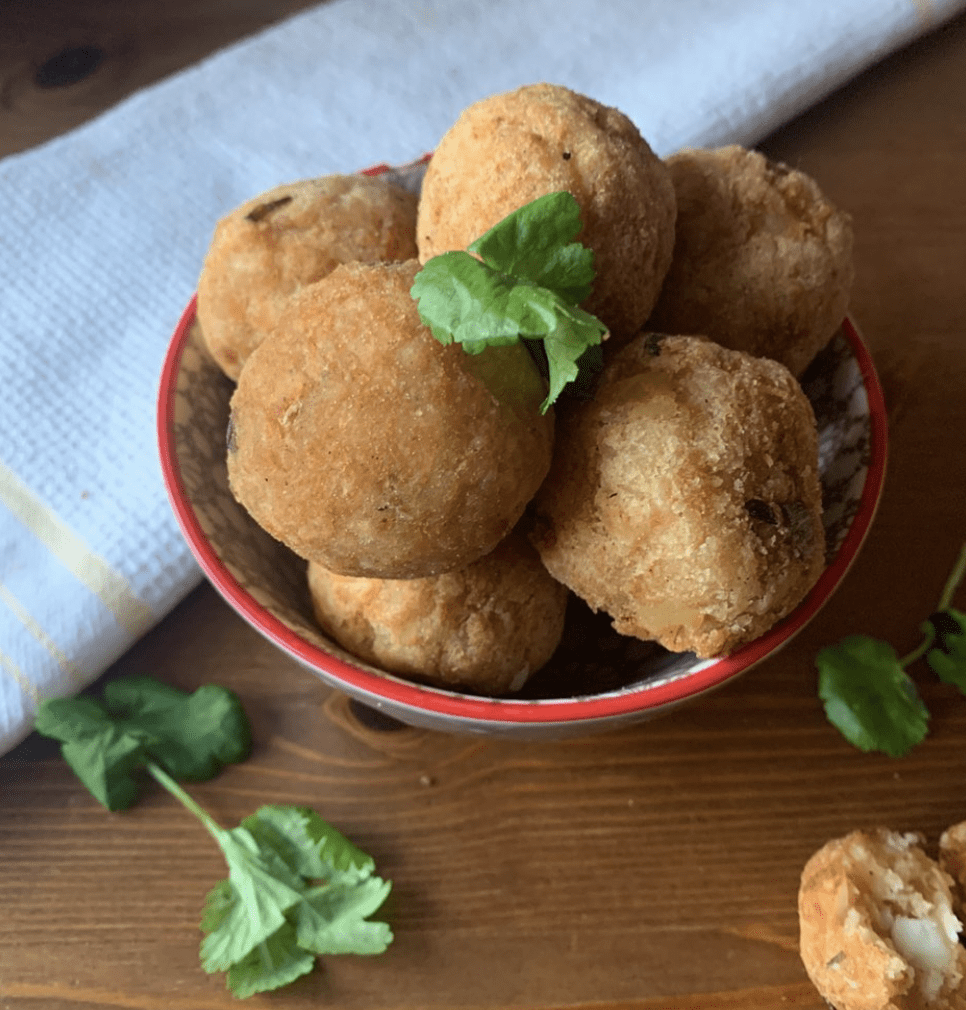

Guyanese Oil Roti: A Versatile and Flavorful Flatbread
Guyanese oil roti is a flatbread which was introduced to Guyana by Indian indentured labourers during the 1800s.
Oil roti is essentially a type of flatbread made from wheat flour, oil, baking soda, yeast, sugar, salt, and water. The dough is prepared by mixing the flour with the baking soda, yeast, sugar, salt, and water . The dough is then kneaded until it becomes smooth then left to rest. After that, it is divided into small balls and rolled out into thin, circular shapes.
Each circle of dough is coated with oil then it is rolled into a log then rolled into a shape similar to that of a cinnamon roll and left to rest again. Each oiled portion of dough is rolled out into a thin circle again before it is cooked on a hot griddle or tawa, where it is brushed with oil to prevent it from sticking and for it to cook properly on both sides. When done, the cooked roti is folded in half and clapped between two hands several times to break it up a bit.
Guyanese oil roti is often enjoyed as a staple accompaniment to various dishes. It is commonly served with curries, stews, chutneys or other saucy dishes, as the roti can be torn into pieces and used to scoop up the flavourful sauces. .
Overall, Guyanese oil roti is a versatile and delicious bread that reflects the cultural diversity and culinary fusion of Guyana.
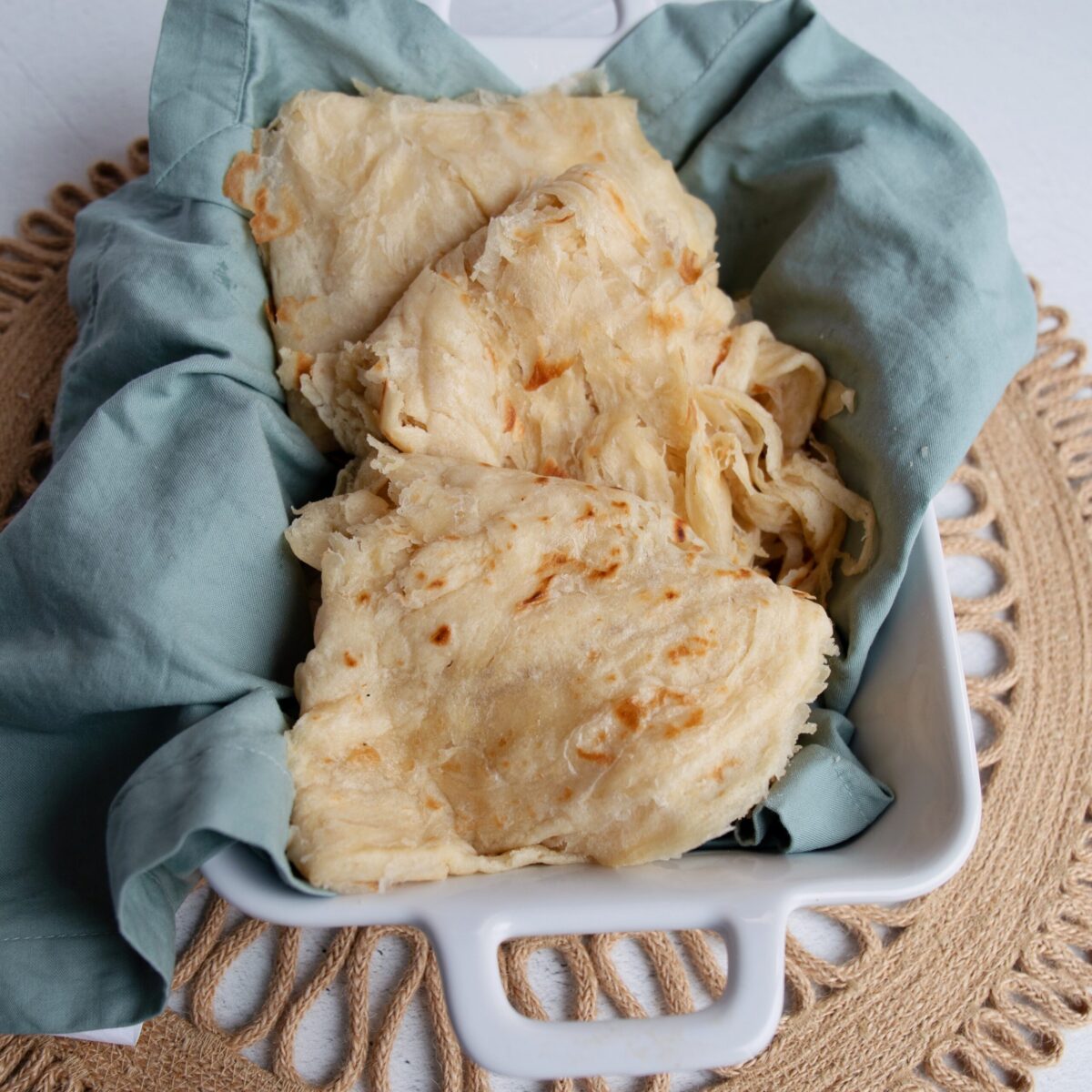

Recipe: Pholourie by Alica of AlicasPepperpot (Traditional Vegan Fritters)
Pholourie is a popular snack, street food, and appetiser in Guyana. It was created in the 19th Century by the Indians who were recruited as indentured labourers after slavery was abolished who adapted their cultural recipes to the ingredients available in Guyana, neighbouring countries, and nearby Caribbean islands.
It is a traditionally vegan fritter made from split yellow peas, which are soaked and blended with a mixture of various aromatics, spices and seasonings. The typical aromatics and spices used include chilli peppers (wiri wiri or scotch bonnet), cumin, garlic, and turmeric. These give pholourie its distinct flavor. Additional ingredients such as baking powder, yeast, flour, salt, and water are added to form a thick batter.
To prepare pholourie, the batter is dropped, by hand, into hot oil and then deep-fried until golden brown. Although dropping the batter into the oil is the traditional method for making round pholourie, those wary about dropping the batter into hot oil by hand can spoon or pipe it into the oil. The frying process gives pholourie its crispy exterior. Once cooked, the pholourie balls are usually served hot and paired with tangy and flavourful chutneys and sours such as lime sour, mango chutney, tamarind sour and/or a chilli pepper sauce for dipping.
In this recipe, Alica of AlicasPepperpot.com and @alicaspepperpot on Instagram shows how she makes her delicious and irresistible pholourie.


Article by Samantha Onyemenam. Featured Image Credit: Alica from Alica’s Pepperpot.
SAVE/PIN/SHARE THIS ARTICLE











